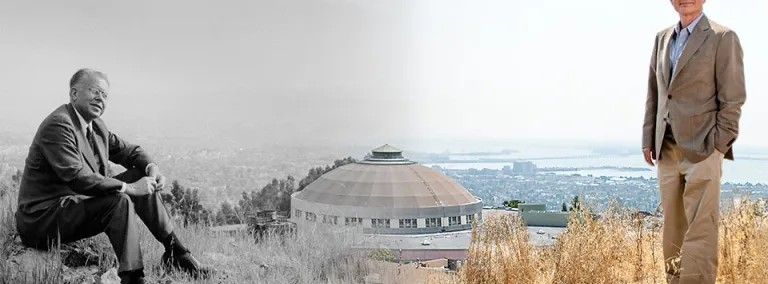Nobel Day celebrates South Dakota’s Nobel Laureate in Physics
Berkeley Lab director Mike Witherell will present about Nobel Laureate Ernest O. Lawrence and the invention of big science
In celebration of Nobel Day, Sanford Underground Research Facility (Sanford Lab) will host Dr. Michael Witherell, director of Lawrence Berkeley National Laboratory (Berkeley, as our speaker for the Nobel Day edition of Deep Talks on Friday, Dec. 13, from 5 to 7 p.m. at the Sanford Lab Homestake Visitor Center.
At “Nobel Day: The Invention of Big Science,” Witherell will present on South Dakota’s own Nobel Laureate, Ernest O. Lawrence. Lawrence won the 1939 Nobel Prize in Physics for his invention of the cyclotron.
“We’re proud to welcome Dr. Mike Witherell to Sanford Lab for Nobel Day,” said Mike Headley, executive director of Sanford Lab. “Mike has been a strong partner with Sanford Lab for many years as both a researcher and lab director. We’re looking forward to Mike’s presentation on a fellow South Dakotan’s Nobel Prize-winning work.”
Witherell is a leading physicist with a highly distinguished career in teaching, research and managing complex organizations. He has received numerous honors and recognitions for his scientific contributions and achievements. Witherell is the former director of the Fermi National Accelerator Laboratory (Fermilab) in northern Illinois and held the Presidential Chair in Physics at the University of California Santa Barbara where he was also vice chancellor for research. In 2016, Witherell was appointed the director of LBNL, the laboratory originally founded by Ernest O. Lawrence.
Throughout his career, Witherell has seen first-hand the echoes of Lawrence’s contributions to science in the US.
Lawrence was born and raised in Canton, S.D. He graduated from the University of South Dakota before getting a master’s at the University of Minnesota and his doctorate at Yale University. Lawrence was a 28-year-old assistant professor, who had just been recruited to UC Berkeley from Yale, when he envisioned the circular device capable of accelerating nuclear particles to extremely high speeds without the use of high voltage. Small enough to hold in his hands, the original cyclotron ushered in the era of giant “atom smashers” housed under domes—in the United States and at particle physics laboratories around the world. Cyclotrons set off a whirl of discovery that included new elements, isotopes, subatomic particles and the birth of nuclear medicine.
“Lawrence’s contributions to science stretch beyond his invention of the first cyclotron to his conception of team science: how a large number of people working together can accomplish huge discoveries,” Witherell said. “Before his time, science was done by individuals in separate laboratories. As he began working on large accelerators, he realized this work could not be done by an individual.”
Lawrence gathered a team of expert physicists, biologists, chemists and medical researchers, two of whom, Edwin M. McMillan and Luis W. Alvarez, would also receive a Nobel Prize in Physics. On his original team was Robert Wilson, a 25-year-old graduate student who would become the first laboratory director of Fermilab, the nation's premiere high-energy physics laboratory.
“Wilson learned big science from Lawrence and modeled Fermilab in the same way,” said Witherell, who himself became the director of Fermilab in 1999.
As a member of the LUX collaboration, Witherell helped advance the search for dark matter with a detector housed on the 4850 Level of Sanford Lab. He was also part of the international research team that designed the next-generation LUX-ZEPLIN (LZ) dark matter experiment, which is currently being assembled in the same underground cavern that housed LUX.
“LZ is collaborative science—exactly like Lawrence used to do—studying fundamental particles of matter—just like Lawrence did,” Witherell said.
As director of Berkeley Lab, Witherell’s career continues to intersect Lawrence’s legacy. Witherell is working to enhance the Advanced Light Source (ALS), a particle accelerator that generates bright beams of x-ray light for scientific research, in the same iconic domed building that first housed Lawrence’s largest cyclotron.
At “Nobel Day: The Invention of Big Science,” we invite you to discover the connections between Lawrence’s innovative science then and ongoing research today, globally and at Sanford Lab. At this event, we will also be presenting the 2019 CORES Award (Communication OutReach Experiences in Science) to South Dakota Public Broadcasting’s “Science” Steve Rokusek. With this award, Sanford Lab recognizes Rokusek for his outstanding and ongoing support of scientific outreach in the region.
Nobel Day: The Invention of Big Science event begins at 5 p.m. on Friday, Dec. 13, at the Sanford Lab Homestake Visitor Center in Lead, S.D. The event begins with a social hour that includes free beer (must be 21 and older to drink) and light snacks. Deep Talks is sponsored by Crow Peak Brewing Company of Spearfish, S.D.
